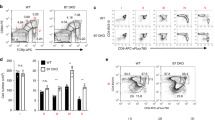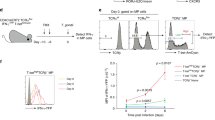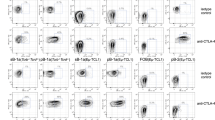Abstract
When antigen-presenting cells (APCs) encounter inflammatory stimuli, they up-regulate their expression of B7. A small amount of B7 is also constitutively expressed on resting APCs, but its function is unclear. Here we show that initiation of T cell responses requires the expression of B7 on immunizing APCs, but the responses are much greater in the absence of basal B7 expression. Transfer of antigen-specific CD4+CD25+ cells reverses the increased responsiveness, and tolerance to a self-protein is broken by immunization in the absence of basal B7, thereby inducing autoimmunity. Similar loss of self-tolerance is seen on depletion of CD25+ cells. Thus, constitutively expressed B7 costimulators function to suppress T cell activation and maintain self-tolerance, principally by sustaining a population of regulatory T cells.
This is a preview of subscription content, access via your institution
Access options
Subscribe to this journal
Receive 12 print issues and online access
$209.00 per year
only $17.42 per issue
Buy this article
- Purchase on Springer Link
- Instant access to full article PDF
Prices may be subject to local taxes which are calculated during checkout






Similar content being viewed by others
References
Banchereau, J. & Steinman, R.M. Dendritic cells and the control of immunity. Nature 392, 245–252 (1998).
Lanzavecchia, A. & Sallusto, F. The instructive role of dendritic cells on T cell responses: lineages, plasticity and kinetics. Curr. Opin. Immunol. 13, 291–298 (2001).
Coyle, A.J. & Gutierrez-Ramos, J.C. The expanding B7 superfamily: increasing complexity in costimulatory signals regulating T cell function. Nat. Immunol. 2, 203–209 (2001).
McAdam, A.J., Schweitzer, A.N. & Sharpe, A.H. The role of B7 co-stimulation in activation and differentiation of CD4+ and CD8+ T cells. Immunol. Rev. 165, 231–247 (1998).
Lenschow, D.J., Walunas, T.L. & Bluestone, J.A. CD28/B7 system of T cell costimulation. Annu. Rev. Immunol. 14, 233–258 (1996).
Shahinian, A. et al. Differential T cell costimulatory requirements in CD28-deficient mice. Science 261, 609–612 (1993).
Borriello, F. et al. B7-1 and B7-2 have overlapping, critical roles in immunoglobulin class switching and germinal center formation. Immunity 6, 303–313 (1997).
Sharpe, A.H. & Freeman, G.J. The B7-CD28 superfamily. Nat. Rev. Immunol. 2, 116–126 (2002).
Ranheim, E.A. & Kipps, T.J. Activated T cells induce expression of B7/BB1 on normal or leukemic B cells through a CD40-dependent signal. J. Exp. Med. 177, 925–935 (1993).
Larsen, C.P. et al. Regulation of immunostimulatory function and costimulatory molecule (B7-1 and B7-2) expression on murine dendritic cells. J. Immunol. 152, 5208–5219 (1994).
de Boer, M. et al. Ligation of B7 with CD28/CTLA-4 on T cells results in CD40 ligand expression, interleukin-4 secretion and efficient help for antibody production by B cells. Eur. J. Immunol. 23, 3120–3125 (1993).
Lenschow, D.J. et al. Long-term survival of xenogeneic pancreatic islet grafts induced by CTLA4lg. Science 257, 789–792 (1992).
Linsley, P.S. et al. Immunosuppression in vivo by a soluble form of the CTLA-4 T cell activation molecule. Science 257, 792–795 (1992).
Inaba, K. et al. The tissue distribution of the B7-2 costimulator in mice: abundant expression on dendritic cells in situ and during maturation in vitro. J. Exp. Med. 180, 1849–1860 (1994).
Azuma, M. et al. B70 antigen is a second ligand for CTLA-4 and CD28. Nature 366, 76–79 (1993).
Kearney, E.R., Pape, K.A., Loh, D.Y. & Jenkins, M.K. Visualization of peptide-specific T cell immunity and peripheral tolerance induction in vivo. Immunity 1, 327–339 (1994).
Kurts, C. et al. Constitutive class I–restricted exogenous presentation of self antigens in vivo. J. Exp. Med. 184, 923–930 (1996).
Camacho, S.A. et al. A key role for ICAM-1 in generating effector cells mediating inflammatory responses. Nat. Immunol. 2, 523–529 (2001).
Salomon, B. et al. B7/CD28 costimulation is essential for the homeostasis of the CD4+CD25+ immunoregulatory T cells that control autoimmune diabetes. Immunity 12, 431–440 (2000).
Tivol, E.A. et al. Loss of CTLA-4 leads to massive lymphoproliferation and fatal multiorgan tissue destruction, revealing a critical negative regulatory role of CTLA-4. Immunity 3, 541–547 (1995).
Waterhouse, P. et al. Lymphoproliferative disorders with early lethality in mice deficient in Ctla-4. Science 270, 985–988 (1995).
Krummel, M.F. & Allison, J.P. CTLA-4 engagement inhibits IL-2 accumulation and cell cycle progression upon activation of resting T cells. J. Exp. Med. 183, 2533–2540 (1996).
Walunas, T.L., Bakker, C.Y. & Bluestone, J.A. CTLA-4 ligation blocks CD28-dependent T cell activation. J. Exp. Med. 183, 2541–2550 (1996).
Perez, V.L. et al. Induction of peripheral T cell tolerance in vivo requires CTLA-4 engagement. Immunity 6, 411–417 (1997).
Greenwald, R.J., Boussiotis, V.A., Lorsbach, R.B., Abbas, A.K. & Sharpe, A.H. CTLA-4 regulates induction of anergy in vivo. Immunity 14, 145–155 (2001).
Takahashi, T. et al. Immunologic self-tolerance maintained by CD25+CD4+ regulatory T cells constitutively expressing cytotoxic T lymphocyte-associated antigen 4. J. Exp. Med. 192, 303–310 (2000).
Sakaguchi, S., Sakaguchi, N., Asano, M., Itoh, M. & Toda, M. Immunologic self-tolerance maintained by activated T cells expressing IL-2 receptor α-chains (CD25). Breakdown of a single mechanism of self-tolerance causes various autoimmune diseases. J. Immunol. 155, 1151–1164 (1995).
Takahashi, T. et al. Immunologic self-tolerance maintained by CD25+CD4+ naturally anergic and suppressive T cells: induction of autoimmune disease by breaking their anergic/suppressive state. Int. Immunol. 10, 1969–1980 (1998).
McHugh, R.S. & Shevach, E.M. Cutting edge: depletion of CD4+CD25+ regulatory T cells is necessary, but not sufficient, for induction of organ-specific autoimmune disease. J. Immunol. 168, 5979–5983 (2002).
Onizuka, S. et al. Tumor rejection by in vivo administration of anti-CD25 (interleukin-2 receptor α) monoclonal antibody. Cancer Res. 59, 3128–3133 (1999).
Laurie, K.L., Van Driel, I.R. & Gleeson, P.A. The role of CD4+CD25+ immunoregulatory T cells in the induction of autoimmune gastritis. Immunol. Cell. Biol. 80, 567–573 (2002).
Racke, M.K. et al. Distinct roles for B7-1 (CD-80) and B7-2 (CD-86) in the initiation of experimental allergic encephalomyelitis. J. Clin. Invest. 96, 2195–2203 (1995).
Thornton, A.M. & Shevach, E.M. CD4+CD25+ immunoregulatory T cells suppress polyclonal T cell activation in vitro by inhibiting interleukin 2 production. J. Exp. Med. 188, 287–296 (1998).
Maloy, K.J. & Powrie, F. Regulatory T cells in the control of immune pathology. Nat. Immunol. 2, 816–822 (2001).
Shevach, E.M. CD4+ CD25+ suppressor T cells: more questions than answers. Nat. Rev. Immunol. 2, 389–400 (2002).
Apostolou I, Sarukhan, A., Klein, L. & von Boehmer, H. Origin of regulatory T cells with known specificity for antigen. Nat. Immunol. 3, 756–763 (2002).
Lutz, M.B. et al. An advanced culture method for generating large quantities of highly pure dendritic cells from mouse bone marrow. J. Immunol. Methods 223, 77–92 (1999).
Howland, K.C., Ausubel, L.J., London, C.A. & Abbas, A.K. The roles of CD28 and CD40 ligand in T cell activation and tolerance. J. Immunol. 164, 4465–4470 (2000).
Overbergh, L., Valckx, D., Waer, M. & Mathieu, C. Quantification of murine cytokine mRNAs using real time quantitative reverse transcriptase PCR. Cytokine 11, 305–312 (1999).
Grogan, J.L. et al. Early transcription and silencing of cytokine genes underlie polarization of T helper cell subsets. Immunity 14, 205–215 (2001).
Acknowledgements
We thank C. McArthur for cell sorting; E. Kahn and A. Chodos for technical assistance; C. Benitez for mouse typing; Q. Tang and J. Bluestone for anti-CD25; D. Ginzinger for support with real-time PCR; and members of the Abbas laboratory and J. Bluestone for discussions and review of the manuscript. This work was supported by grants from the US National Institutes of Health (to A.K.A.) and from the Deutsche Forschungsgemeinschaft (to J.L. and B.K.)
Author information
Authors and Affiliations
Corresponding author
Ethics declarations
Competing interests
The authors declare no competing financial interests.
Supplementary information
Supplementary Fig. 1.
Adoptively transferred DO11 T cell are not reduced in spleens of RIP-mOVA mice compared to BALB/c. 5x106 CFSE-labeled DO11 CD4+ T cells were adoptively transferred into irradiated (500cGy) wild-type BALB/c or RIP-mOVA recipients on day 0. Spleens were harvested on d1, d2 and d3, and stained with anti-CD4 and KJ1-26. (a) FACS profile of lymphocytes recovered from spleens of wild-type and RIP-mOVA mice on day 1. The plot on the right is gated on CFSE-labeled CD4+ cells only. (b) Recovered CD4+ KJ1-26+ T cells from spleens of wild-type (open squares) and RIP-mOVA mice (filled diamonds) on day 1, 2 and 3 after adoptive transfer. Indicated numbers show the mean percentage of recovered KJ1-26+ CD4+ cells of transferred CFSE-labeled CD4+ cells from two individual mice. (PDF 223 kb)
Supplementary Fig. 2.
Activated antigen-specific CD4+CD25+ cells from sOVA Tg x DO11 mice mediate suppression in vitro. KJ1-26+CD4+CD25+ cells from sOVA Tg x DO11 mice were purified by cell sorting and activated for 4 days with anti-CD3/anti-CD28 and IL-2. 2.5x104 cells/well were cocultured with KJ1-26-CD4+CD25+ cells from DO11.10 mice (2.5x104/well) and 2.5x104/well mitomycin C treated BALB/c splenocytes and 1 µg/ml of OVA323–339 peptide for 60 h. [3H]thymidine (1 µCi/well) was added during the last 18 h of culture. (PDF 95 kb)
Supplementary Fig. 3.
Intravenous administration of anti-CD25 antibody leads to depletion of CD4+CD25+ cells in RIP-mOVA mice. Wild-type RIP-mOVA mice were injected intravenously with 500 μg of anti-CD25 antibody (Clone PC61). 3 days after injection animals were bled and PBMCs analyzed and compared to control mice. By staining with non-crossreactive anti-CD25 (7D4), depletion efficiency was >90% in all experiments. (PDF 160 kb)
Rights and permissions
About this article
Cite this article
Lohr, J., Knoechel, B., Jiang, S. et al. The inhibitory function of B7 costimulators in T cell responses to foreign and self-antigens. Nat Immunol 4, 664–669 (2003). https://doi.org/10.1038/ni939
Received:
Accepted:
Published:
Issue Date:
DOI: https://doi.org/10.1038/ni939
This article is cited by
-
CD28 engagement inhibits CD73-mediated regulatory activity of CD8+ T cells
Communications Biology (2021)
-
T cell-intrinsic role for Nod2 in protection against Th17-mediated uveitis
Nature Communications (2020)
-
CTLA-4 promotes Foxp3 induction and regulatory T cell accumulation in the intestinal lamina propria
Mucosal Immunology (2013)
-
Aberrant expression of costimulatory molecules in splenocytes of the mevalonate kinase‐deficient mouse model of human hyper‐IgD syndrome (HIDS)
Journal of Inherited Metabolic Disease (2012)
-
Cytotoxic T Cells
Journal of Investigative Dermatology (2006)



